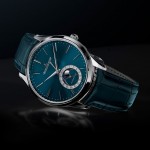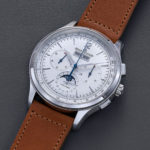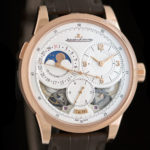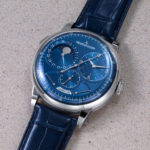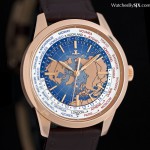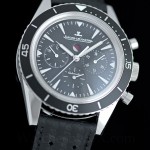Up Close: Jaeger-LeCoultre Duometre Chronograph Moon
A clever chronograph with simple complications.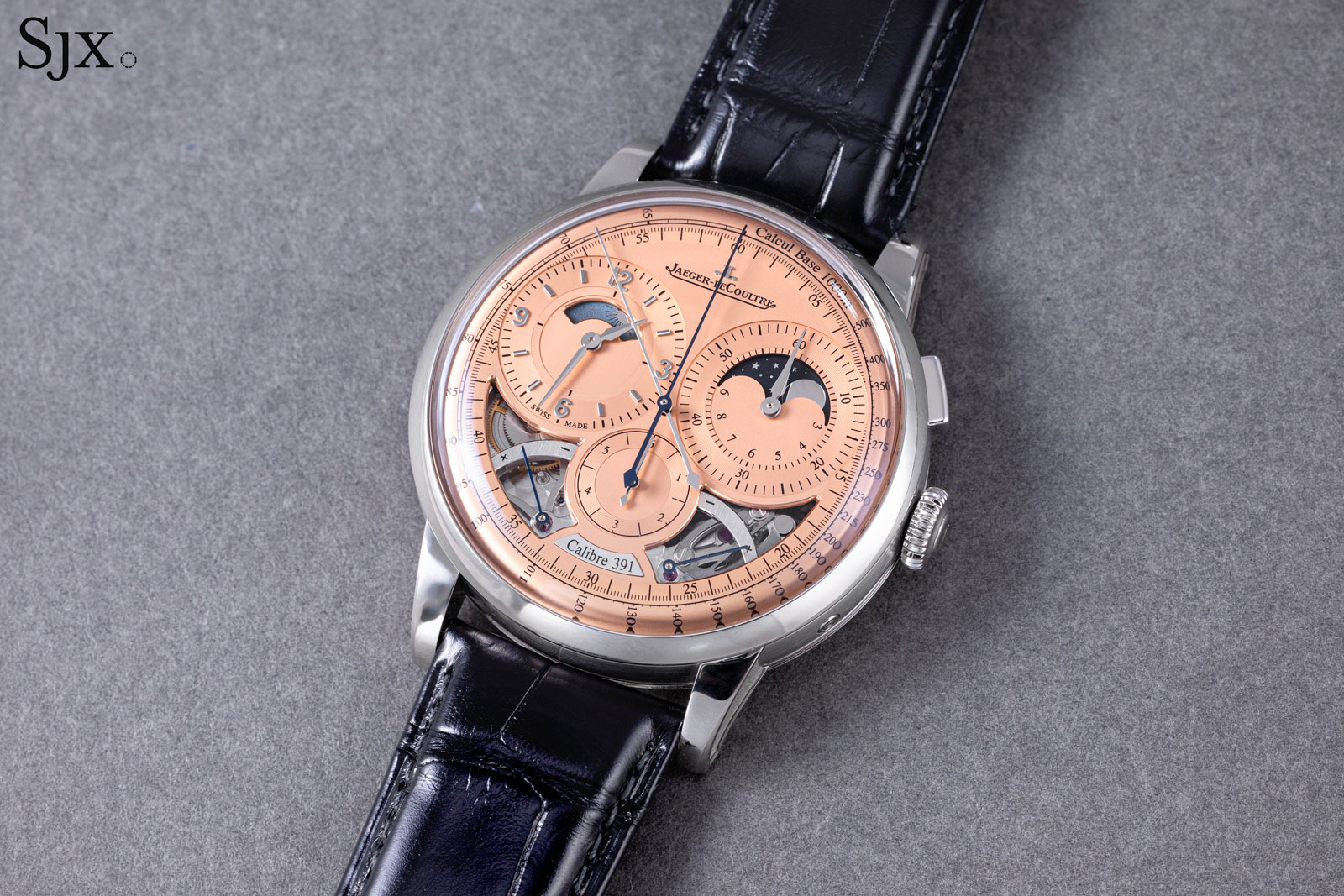
Jaeger-LeCoultre (JLC) debuts the revamped Duometre line earlier this year, including the Duometre Chronograph Moon (and the entry-level Quantieme Lunaire). The watch incorporates almost every possible complication, some clever and others barely related, to create a chronograph that incudes a host of other simple functions, ranging from a day-night indicator to twin power reserves.
Traditionally, the Duometre was centred on the chronograph, which makes this the line’s flagship model. It’s essentially an evolution of the first-generation model, retaining a chronograph mechanism that is compact and clever, but gains additional complications that feel extraneous.
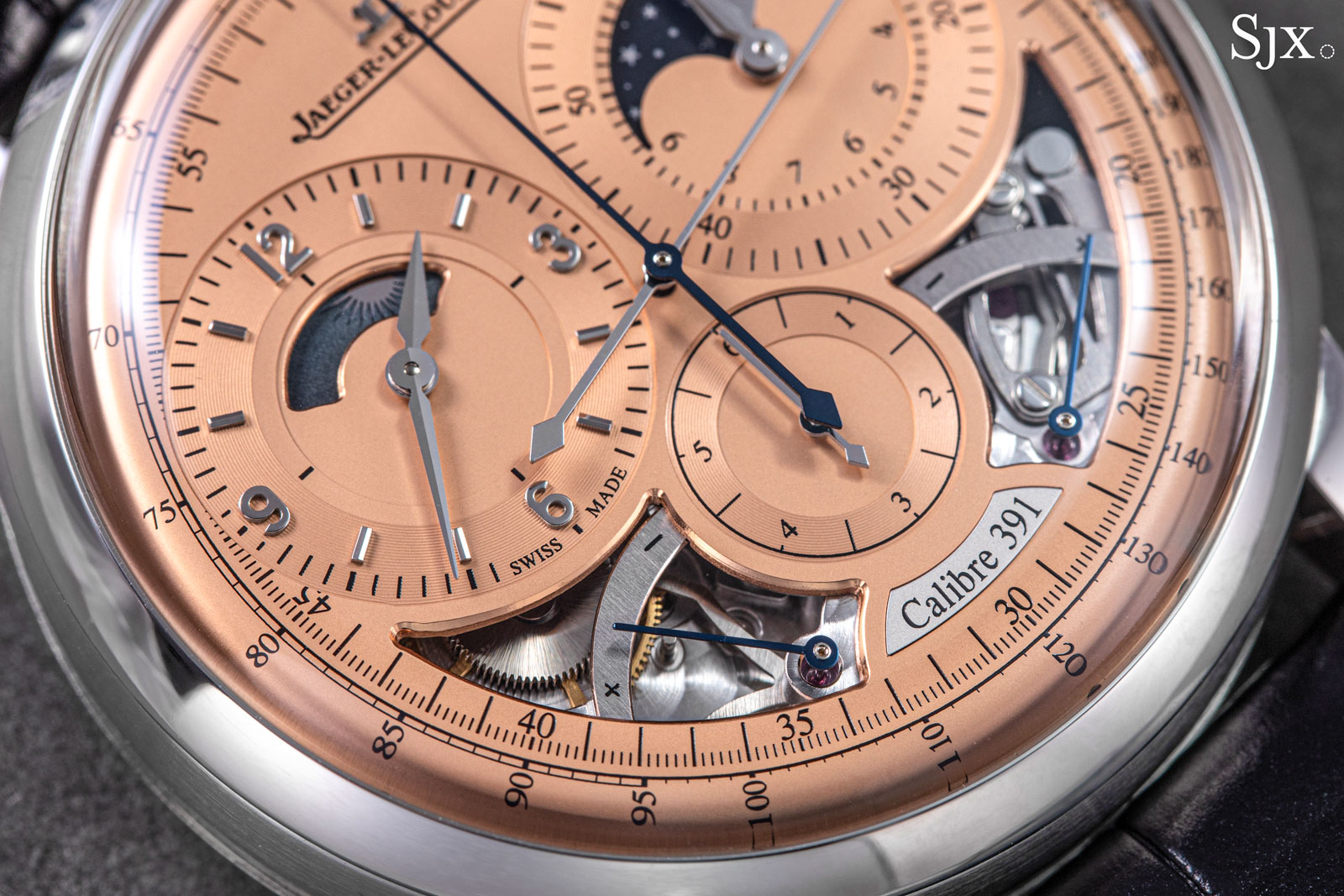
The platinum model gets a copper or “salmon” dial
Initial thoughts
The Duometre Chronograph Moon reflects many of JLC’s strengths, particularly as a movement maker. The movement inside is the sophisticated cal. 391 that makes logical use of the two-train construction to power a smartly designed chronograph mechanism.
Visually, the movement is appealing and boasts quality, workmanlike finishing with details like a free-sprung balance and grande sonnerie-style winding clicks. Although it is industrial haute horlogerie, the calibre is clearly best in class.
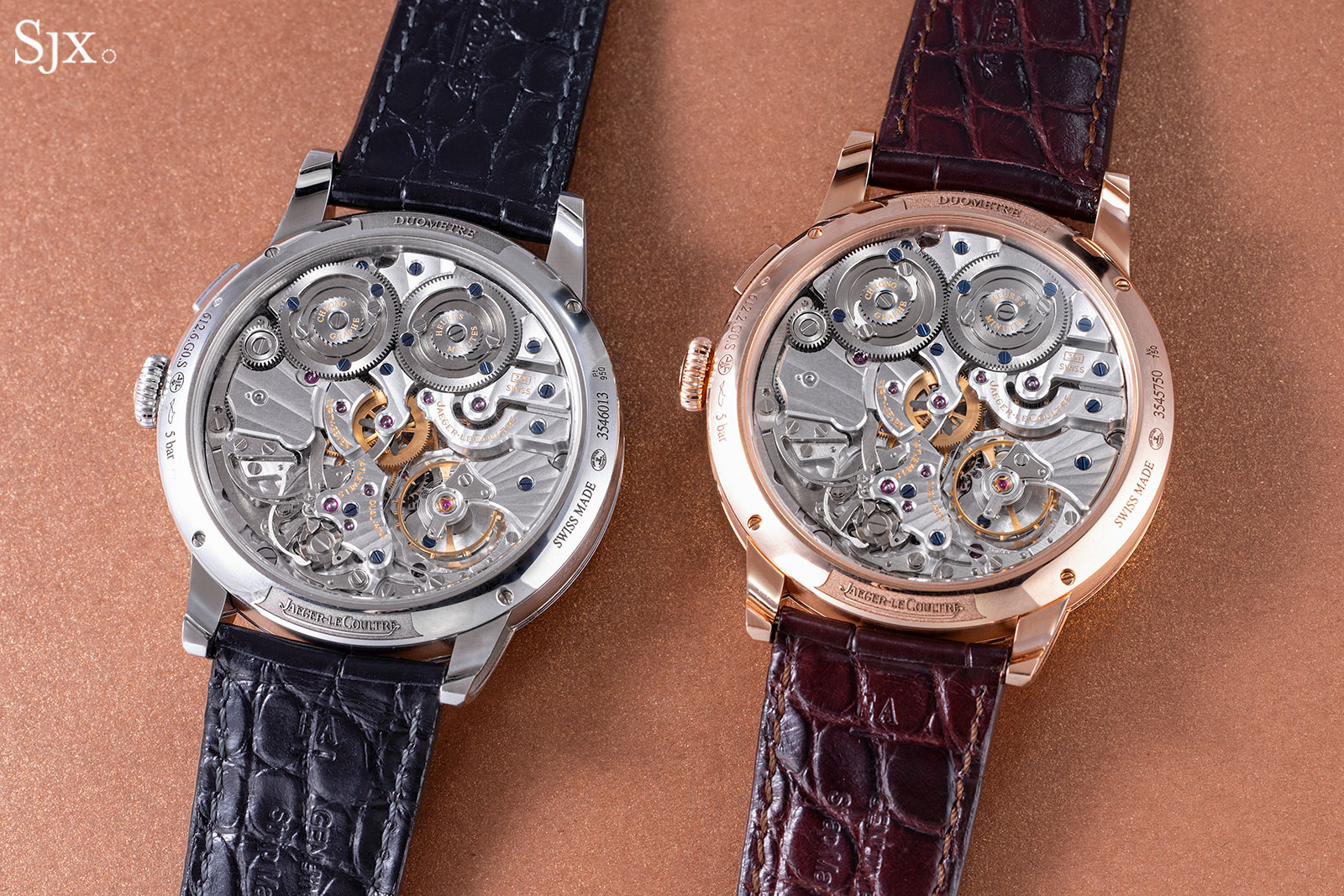
The cal. 391
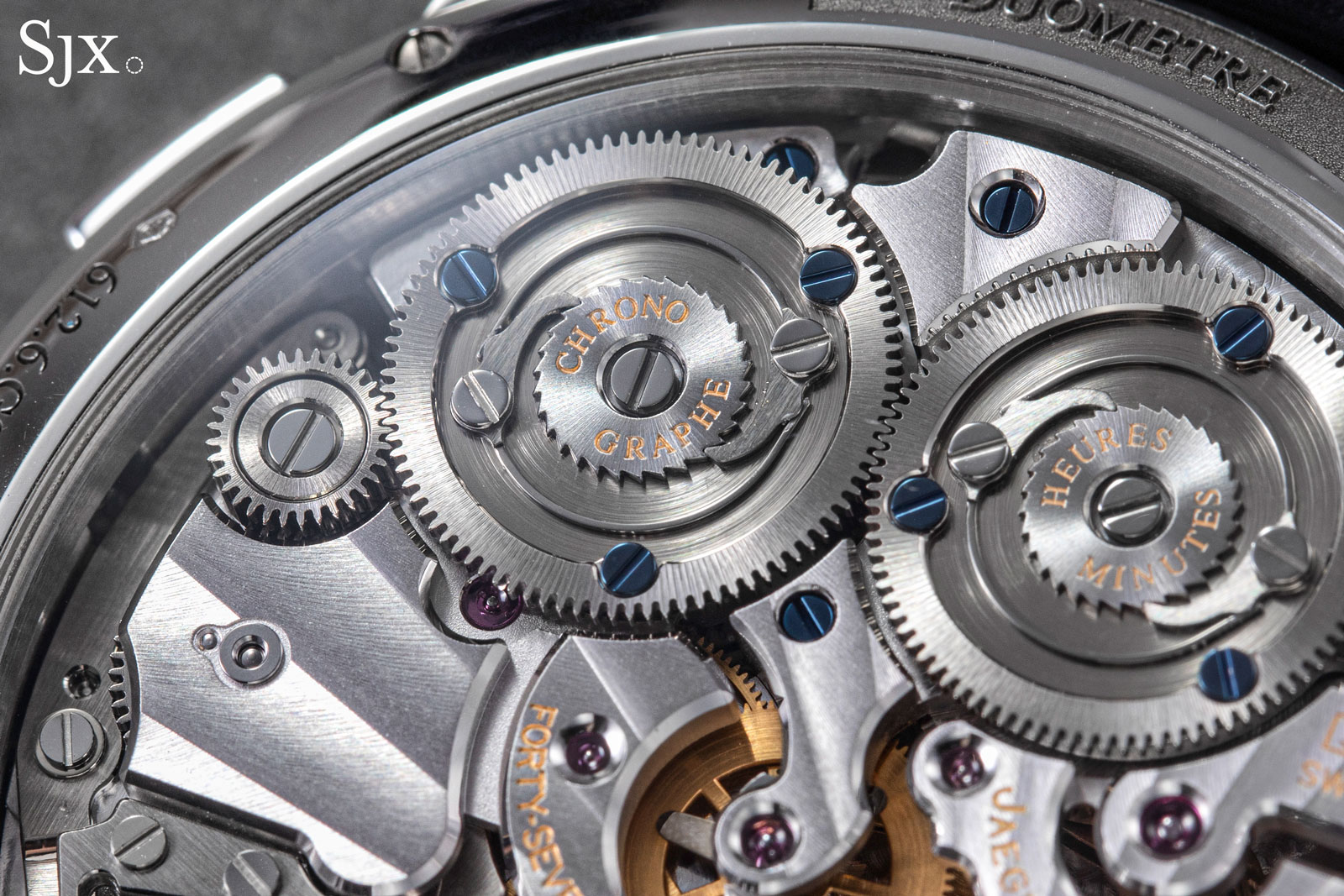
Both barrels each sport grande sonnerie-style winding clicks
But the cal. 391 is nearly identical to the cal. 380 found in the first-generation Duometre introduced in 2007. While it is an accomplished movement, the cal. 391 is hardly novel. Instead it tries to be different by adding simple complications to the chronograph, namely the moon phase and day-night indicator.
These complications add colour to the dial and make the watch seem more complex, but they are mechanically straightforward add-ons that are easy to execute, while also having little relevance to the chronograph. The apertures on the dial further add to the feeling of unnecessary busyness. Leaving out the additional complications would have made the Duometre Chronograph Moon would have been more coherent conceptually and cleaner visually.
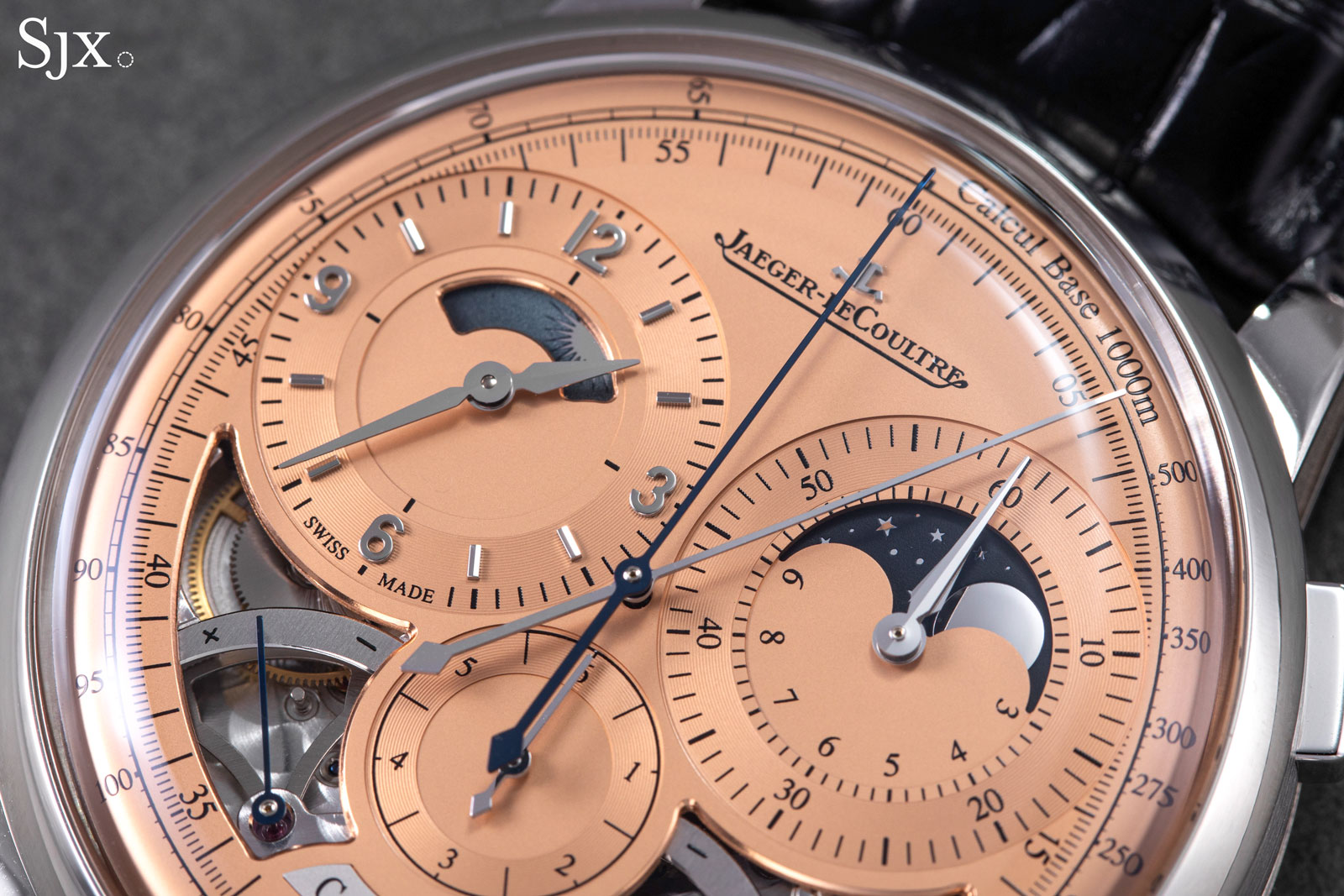
Day-night on the left sub-dial, and moon phase on the right
A storied manufacture like JLC shouldn’t need to add minor complications to an excellent movement for the sake of freshness. Last year’s flagship launch, the Reverso Tribute Chronograph, just repurposed an excellent but 27-year old calibre. The brand used to describe itself as manufacture Jaeger-LeCoultre (MJLC), so one expects more.
That said, the cal. 391 is a beautiful and worth revisiting. But it could have been revisited either as a dated but still appealing movement without adding inessential functions, or with substantive improvements.
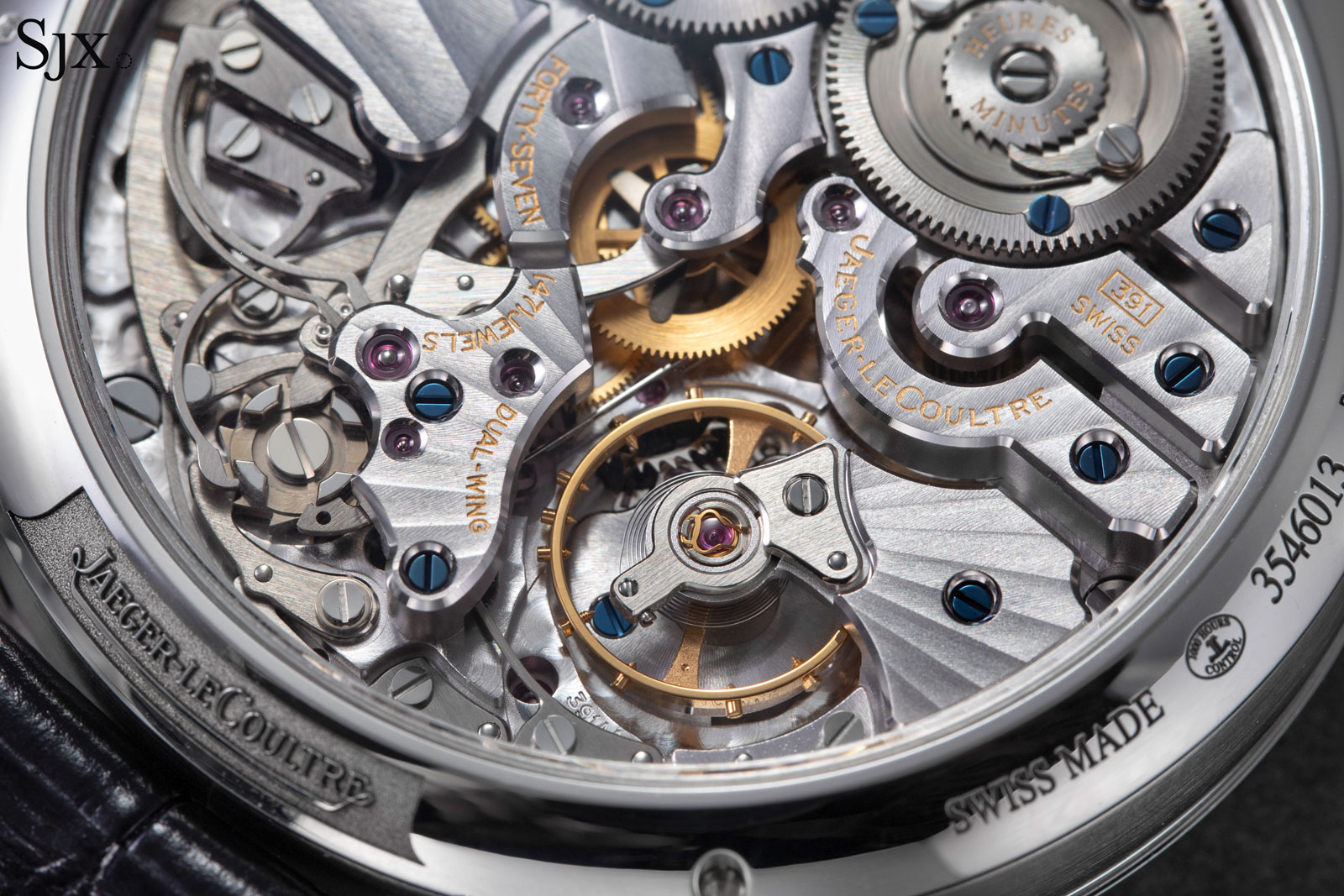
In its original, long-ago iteration, the Duometre Chronograph offered a surprisingly intricate and clever chronograph movement for a competitive price, but that was almost 20 years ago.
Today the Duometre Chronograph Moon costs US$70,000 in pink gold and US$88,000 in platinum. In comparison, the Lange 1815 Chronograph is a bit over US$78,000 in gold, while the Patek Philippe ref. 5172G is US$85,900. This reflects JLC as a whole moving up in the price spectrum, which diminishes the value proposition and makes it harder to compete.
While the Duometre offers more in terms of complexity and functions than the 1815 and ref. 5172G, it doesn’t have the same level of refinement in movement decoration or details, and JLC doesn’t have the cachet of Patek Philippe or A. Lange & Söhne. As the result, even though the Duometre is executed well in many ways, it offers modest value at best.
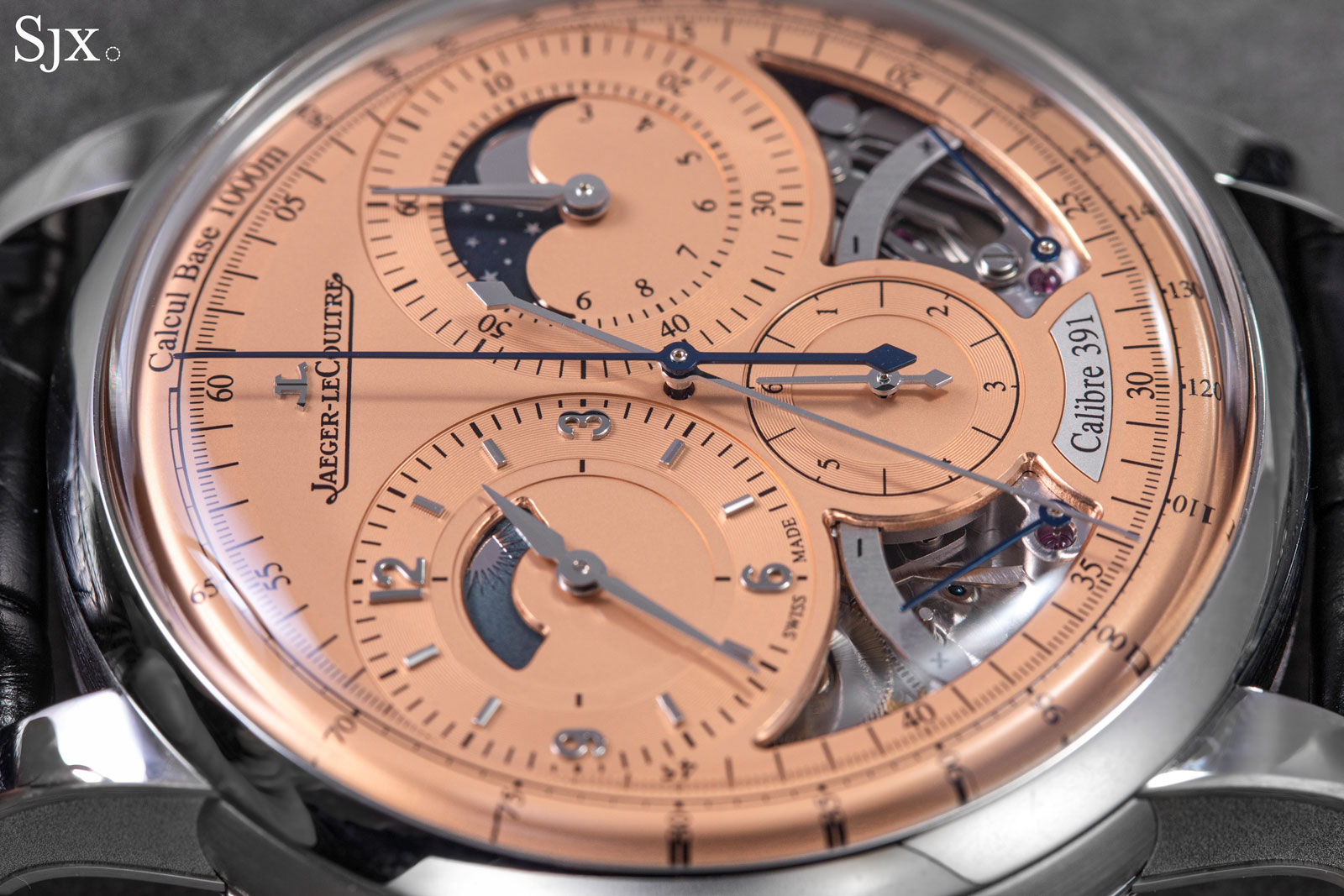
A compact chronograph
The case of the Duometre chronograph is almost identical to the Quantieme Lunaire we reviewed recently, so it holds the same appeal. It’s a large case at 42.5 mm by 14.2 mm, but one with good proportions. The size feels appropriate for the complications and movement, so the dimensions are coherent.
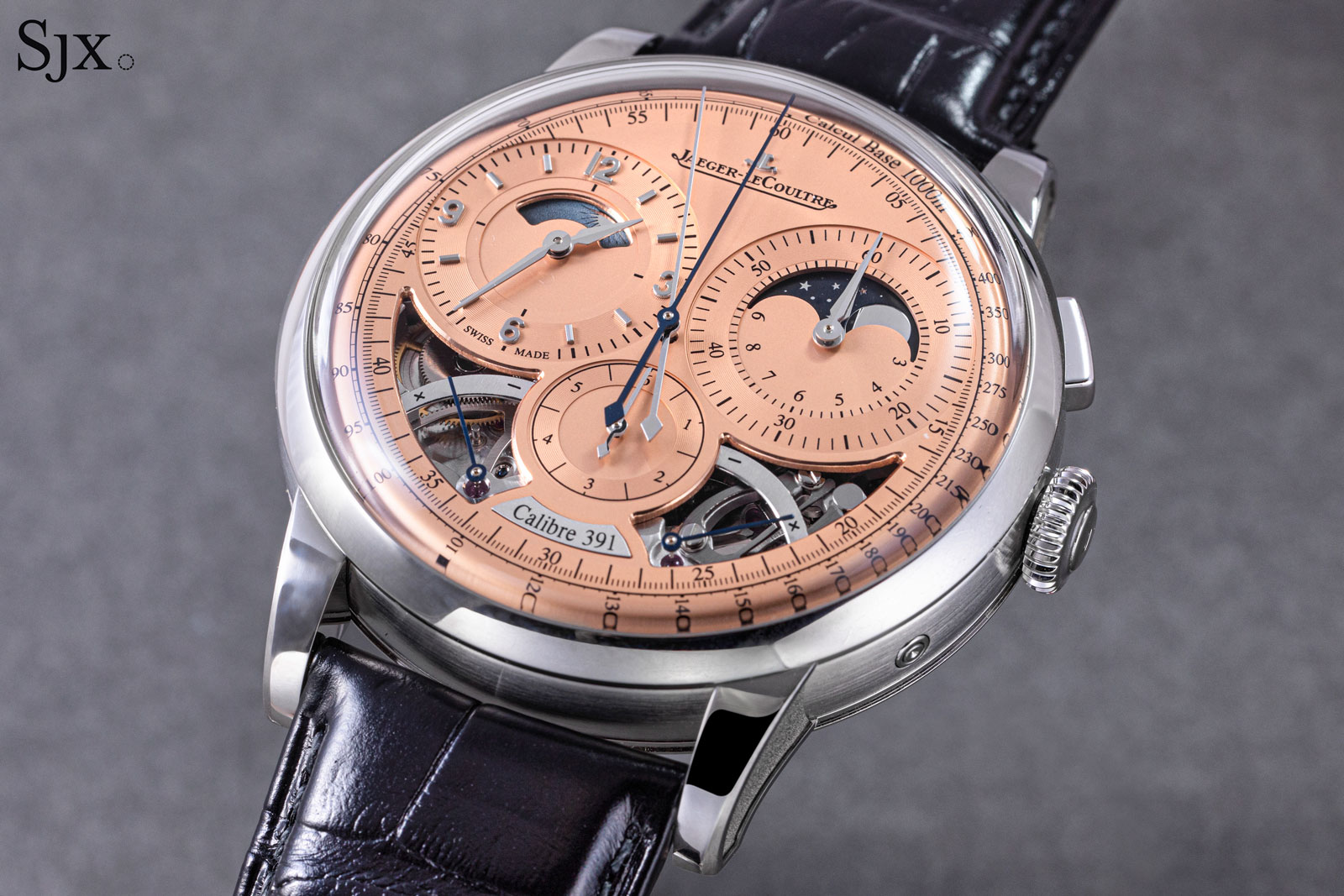
It has a clear vintage-inspired style thanks to the domed dial and crystal, but the detailing on the case sides are a modern touch. The recessed frosting on the lugs are a little like the apertures on the dial – they add detail but necessarily.
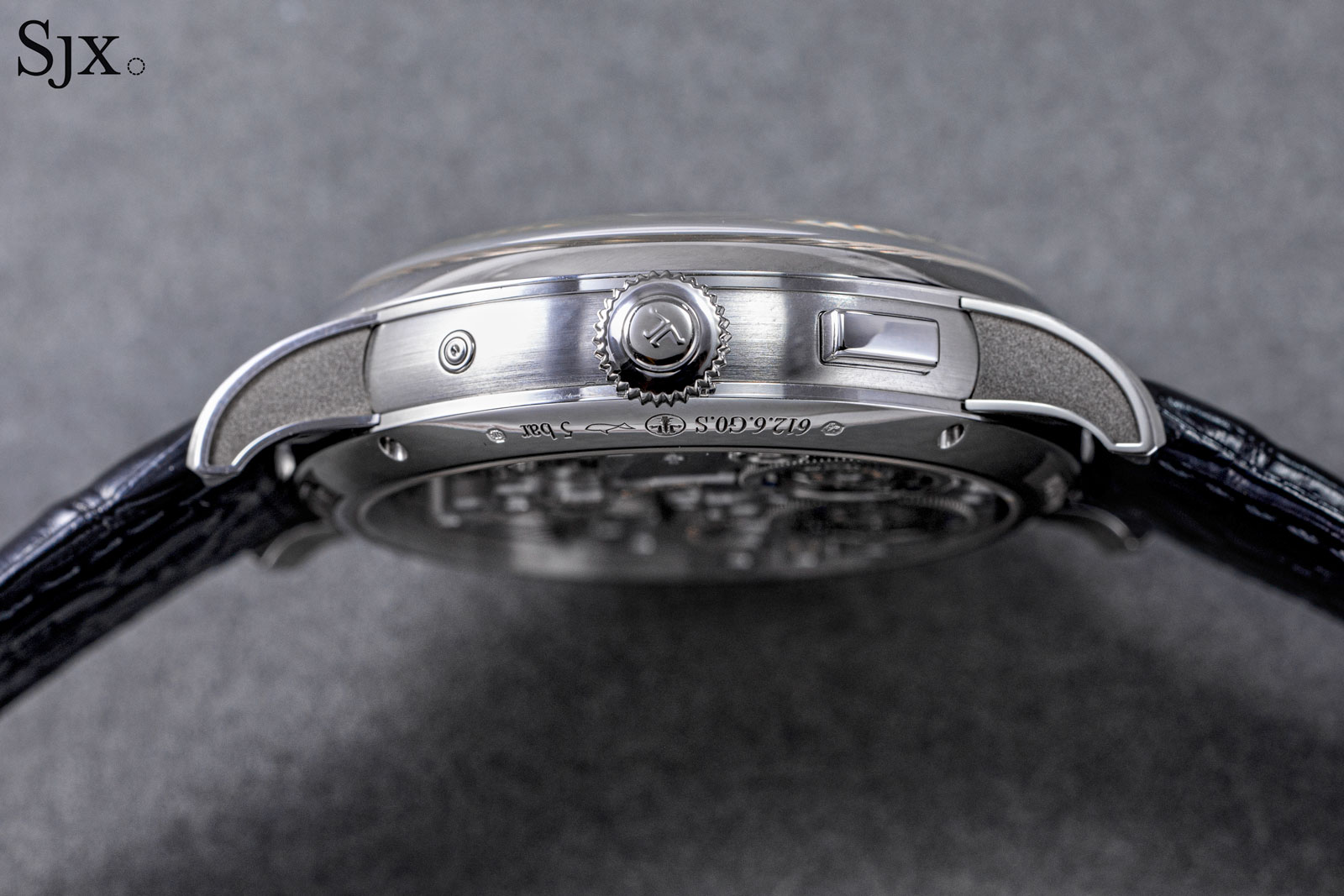
The Duometre Chronograph Moon is only available in pink gold or platinum for now, and both versions are identical save for case material and dial colour.
At first glance the copper (or salmon) dial of the platinum is more striking, but the colour is overused today, leaving this version feeling a bit fashionable. The pink gold model has a classic, almost boring silvered dial, but it works.
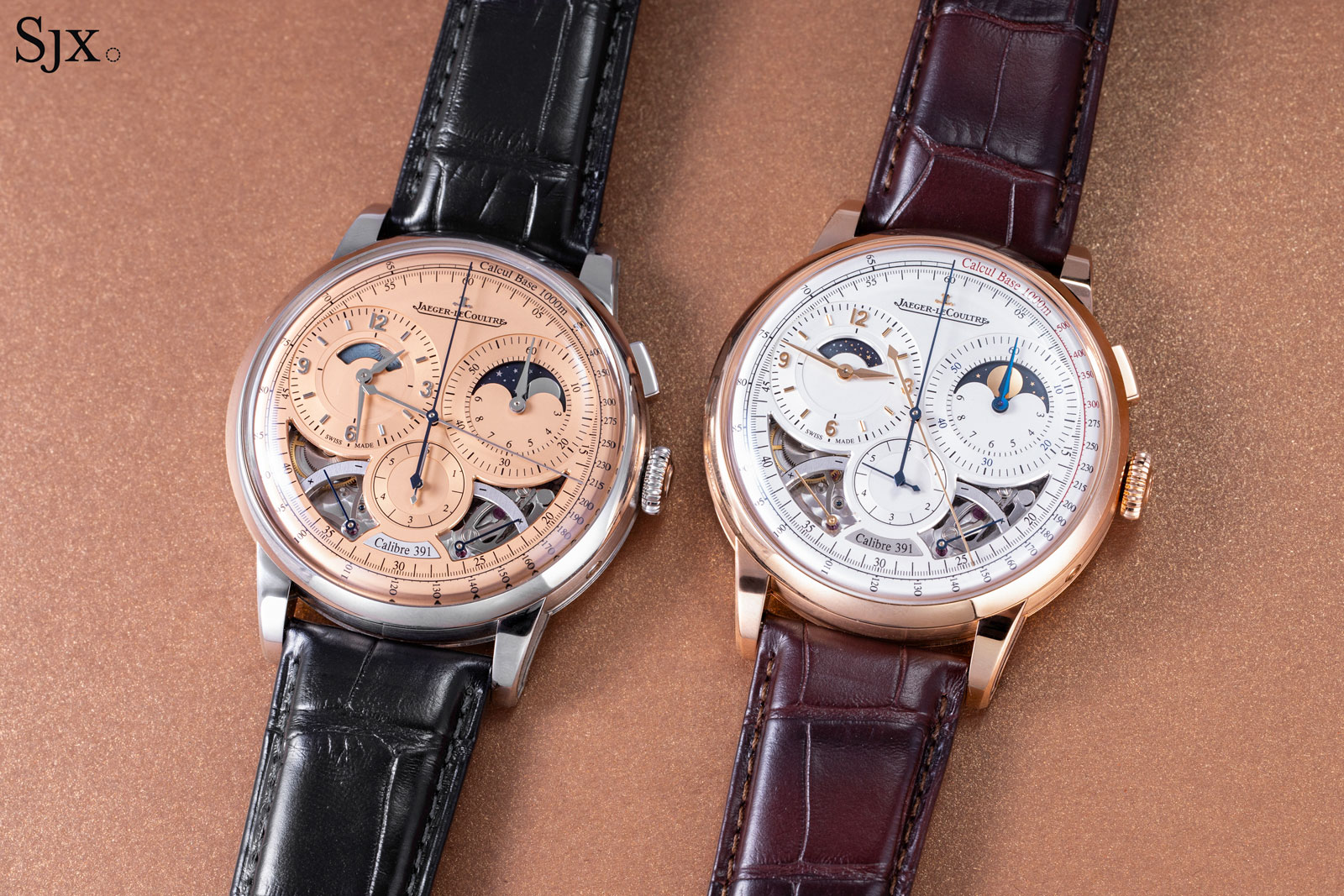
The Duometre Chronograph Moon in platinum (left) and pink gold
Even though the Duometre Chronograph Moon has multiple functions, they are individually relatively simple. But the dial is complex and packed with indicators – not necessarily a good thing since some of the complications aren’t substantive. That said, legibility is surprisingly good despite everything that is on the dial.
As is tradition for the Duometre thanks to its “Dual Wing” movement with two trains, the dial is nearly symmetrical, with each half containing the indicators driven by each going train.
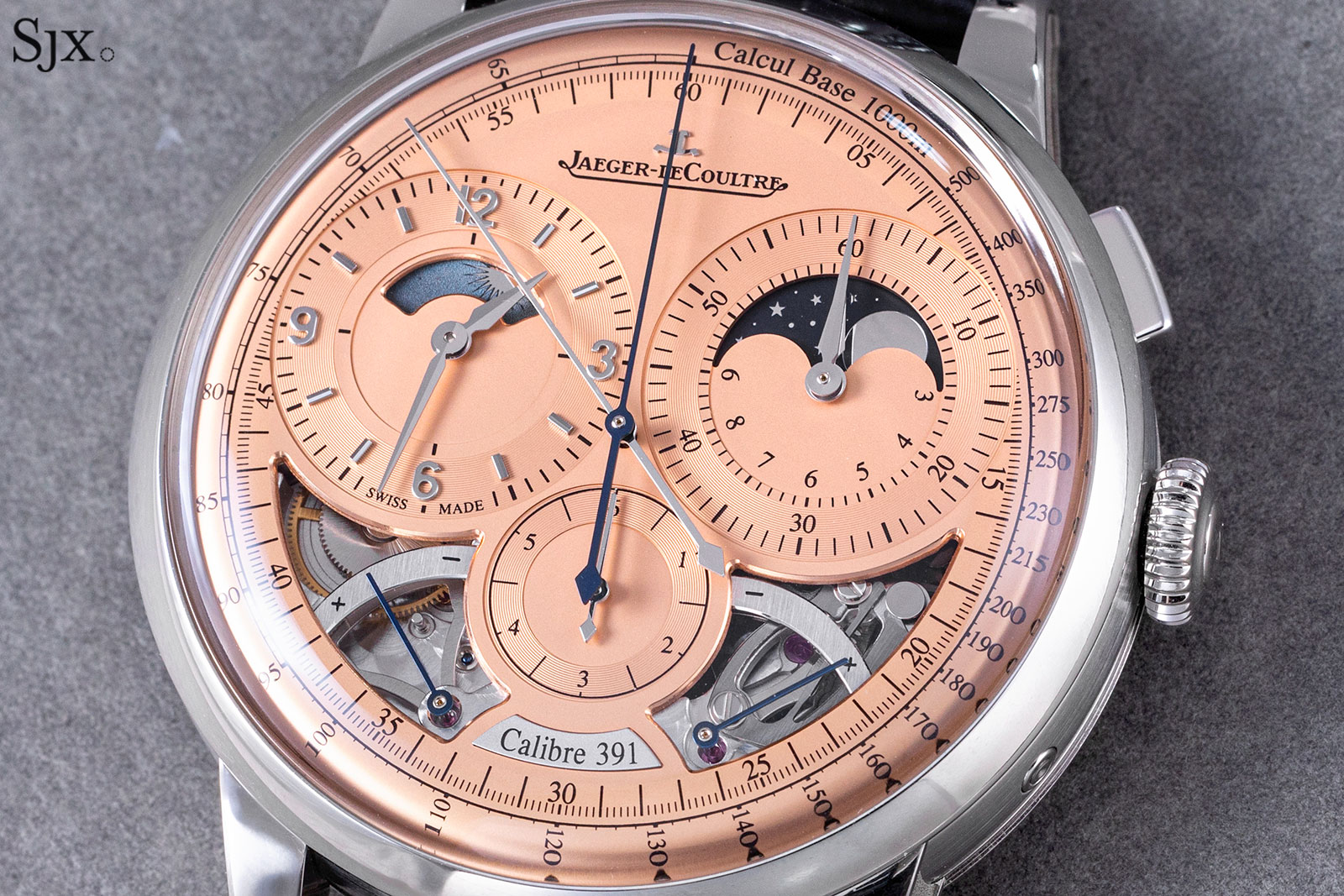
The left register indicates the time as well as day and night, while the right register contains the elapsed hours and minutes along with the moon phase.
The sub-dial at six is for the lightning seconds of the chronographs that measures 1/6th of a second, while the elapsed seconds is on the central blued hand. On either side of the lightning seconds are the power reserve indicators for the timekeeping and chronograph trains.
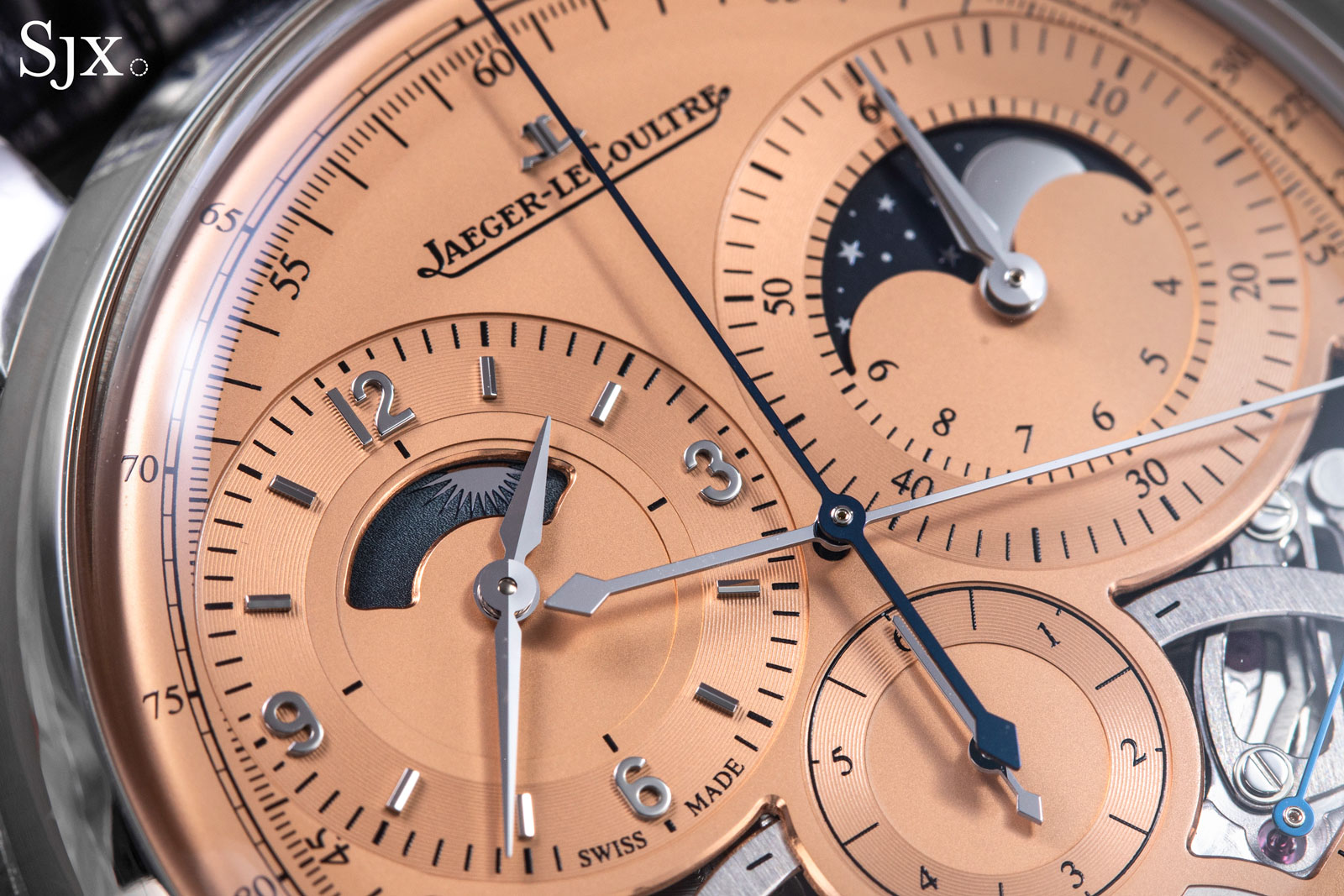
Save for minor tweaks to the scales and excess text, the dial design is well done – but for the twin apertures for the power reserves. These became a standard feature of the Duometre as the model range evolved over the years and have been carried over into the new generation.
The rationale for the wing-shaped apertures is the “Dual Wing” movement and also to add mechanical interest to the dial. But they don’t bring value in terms of design while also throwing the dial off balance. The Quantieme Lunaire omits the apertures and it consequently has a cleaner dial with visual equilibrium.
That said, I can imagine some will like the apertures, as well as the moon phase and day-night displays, for the extra detail they bring to the dial that would otherwise be functional and full of various scales.
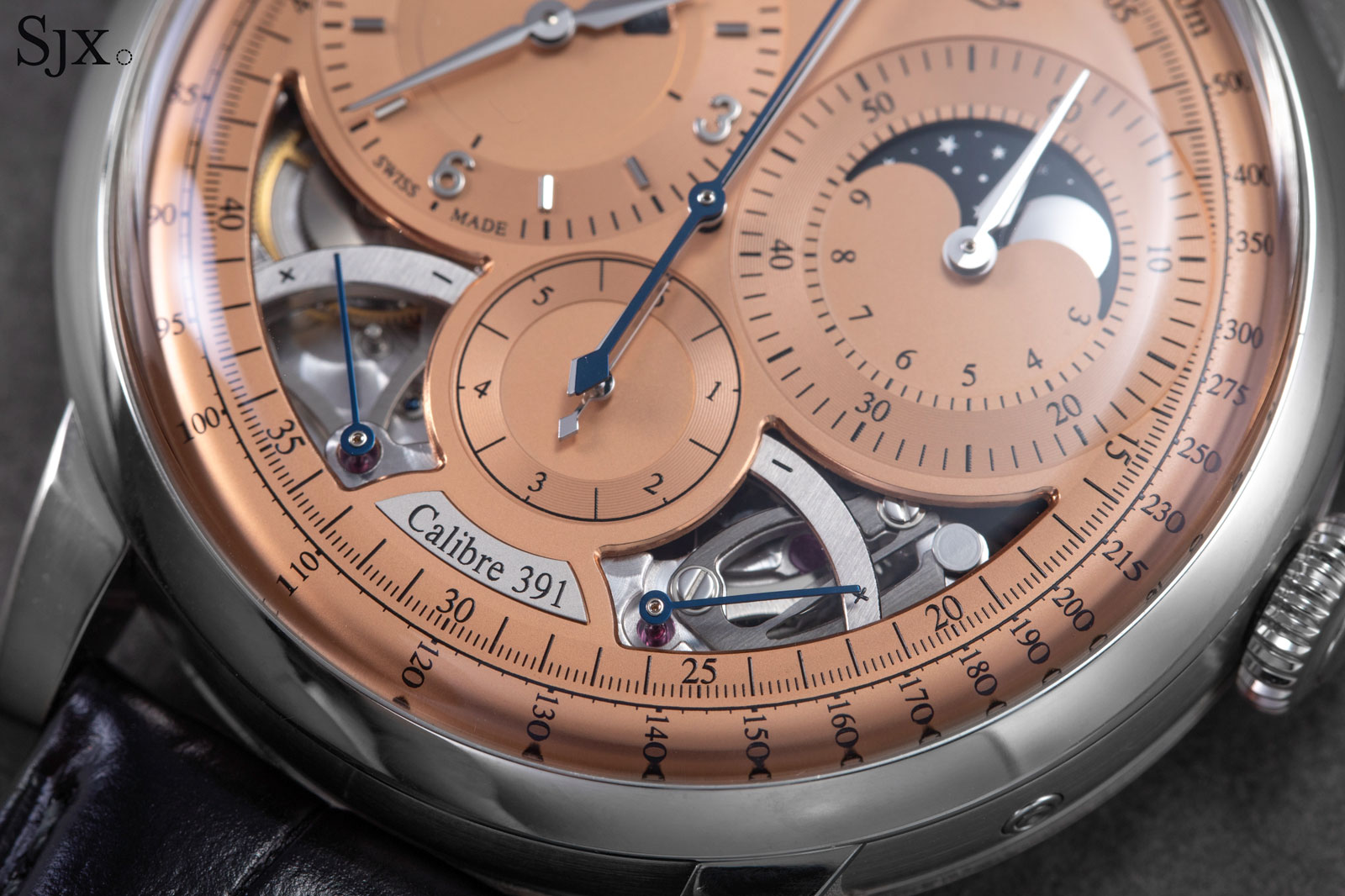
Dual Wing
Strictly speaking, the cal. 391 in the Duometre Chronograph Moon is a new movement as the combination of complications is new. Earlier generations of the Duometre Chronograph did not have the day-night and moon phase indicators.
That said, the cal. 391 is otherwise identical in technical terms of the original Duometre Chronograph cal. 380 (save for some minor tweaks like reshaped levers). The lack of novelty isn’t a criticism, in fact I would have preferred a wholesale revival of the cal. 380 without the twin indicators since that would have created a purer movement from a conceptual perspective.
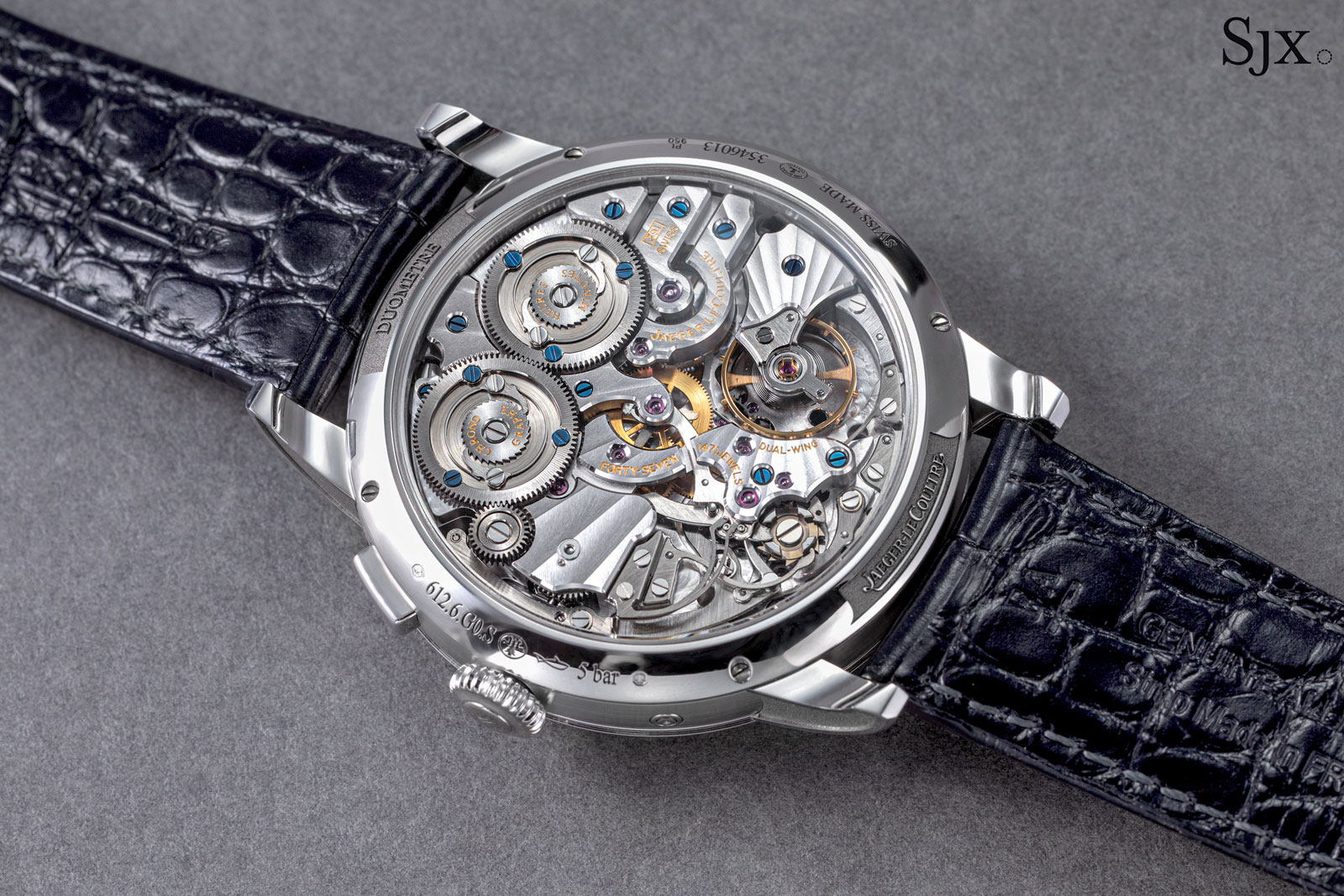
As a result, the cal. 391 retains all of the appeal of its predecessor. It’s clearly a modern construction, but one incorporating old-school details like the double integrated winding clicks, and a traditional balance with regulating screws.
Although the bridges here are rhodium-plated brass, instead of the German silver employed in the cal. 380, the visual appeal is the same. Additionally, there is little difference in terms of cost between the two materials, so it is not a reduction in intrinsic value.
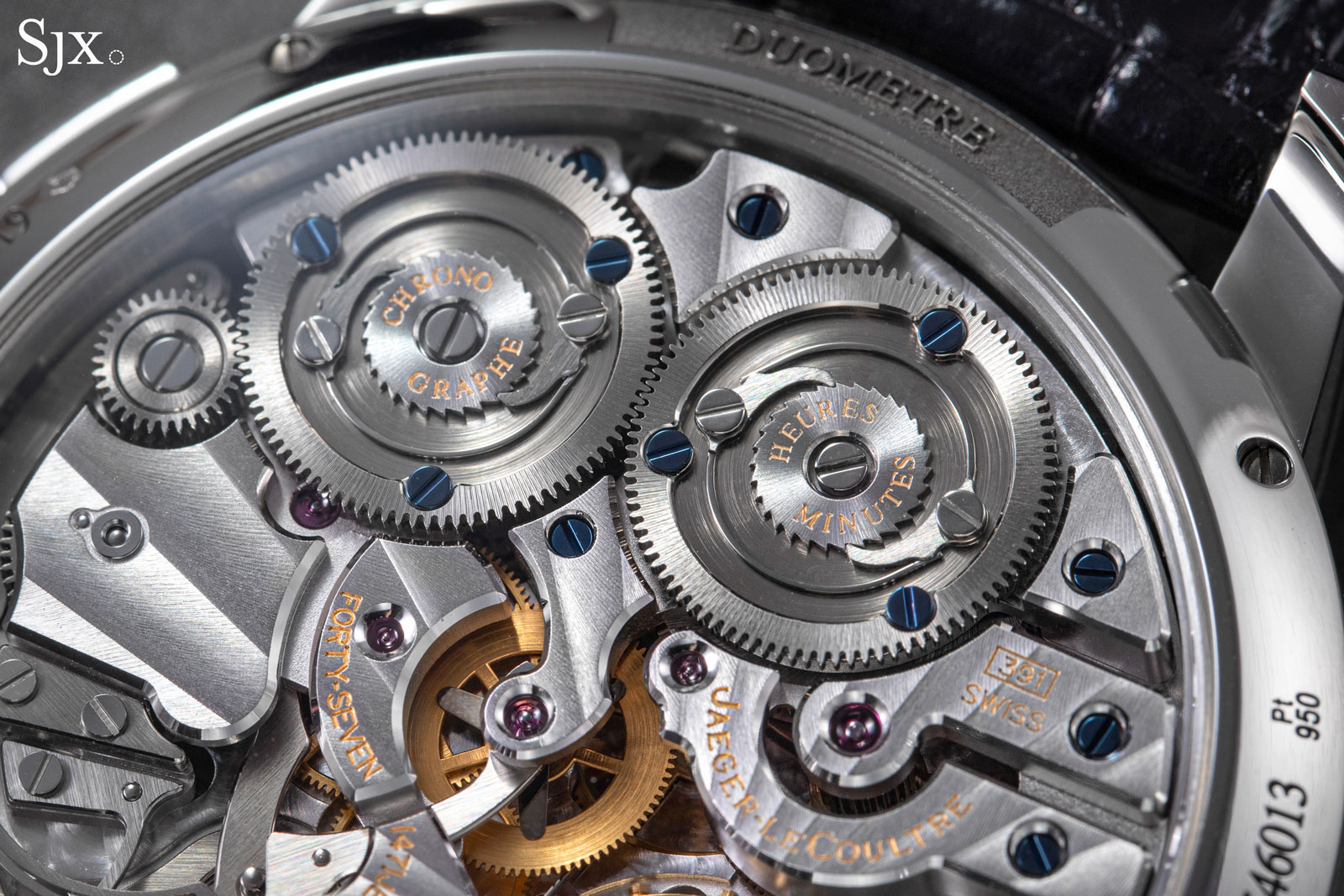
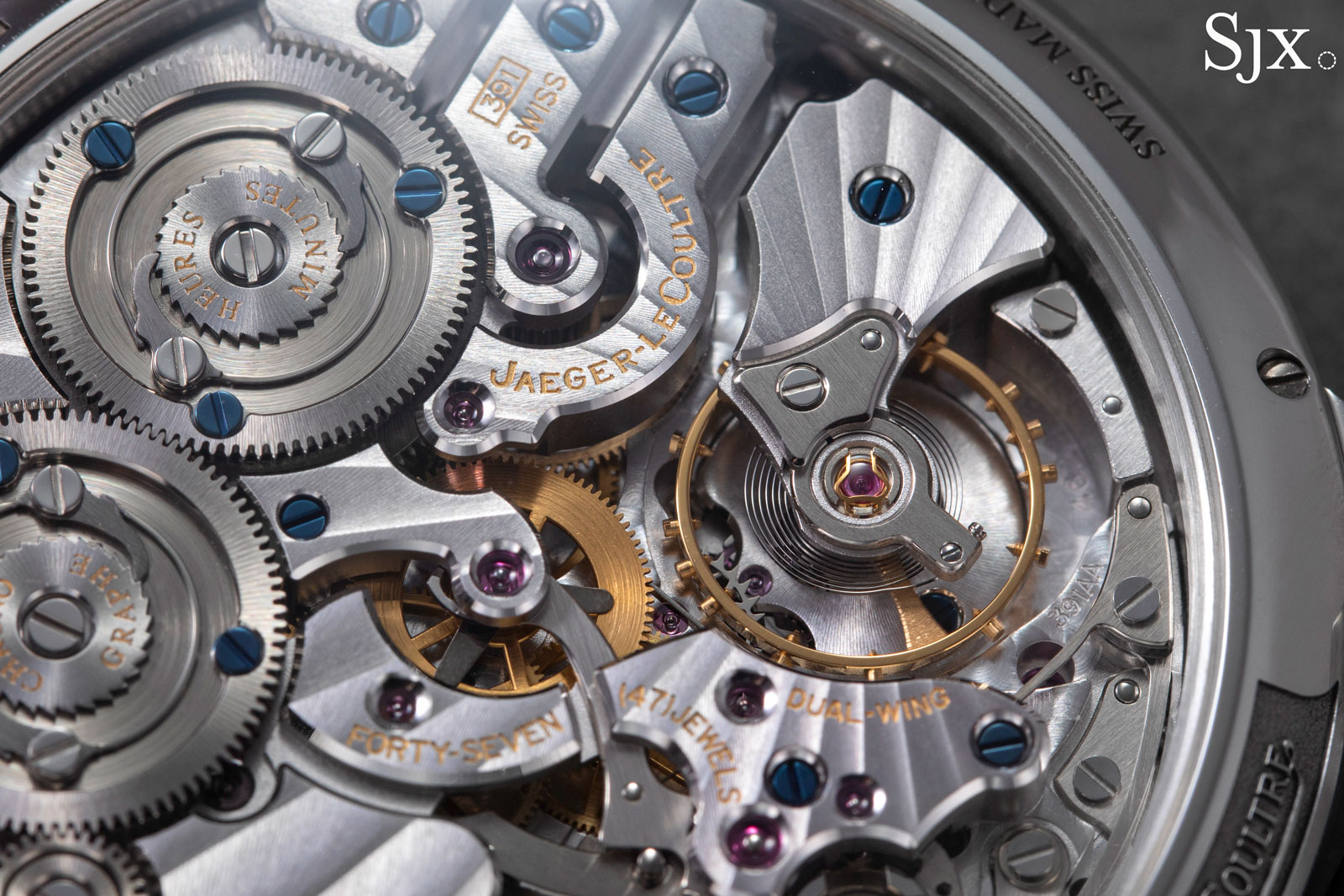
The best part of the movement is the chronograph mechanism that is visible just beside the balance wheel. It’s a notably compact mechanism that maximises the tiny available space, bringing to mind the similarly compact Reverso chronograph as well as historical chronographs designed with space-saving in mind.
The chronograph also adds to the visual balance of the movement, as the Duometre calibres without a chronograph instead have a large, flat bridge where the chronograph would be.
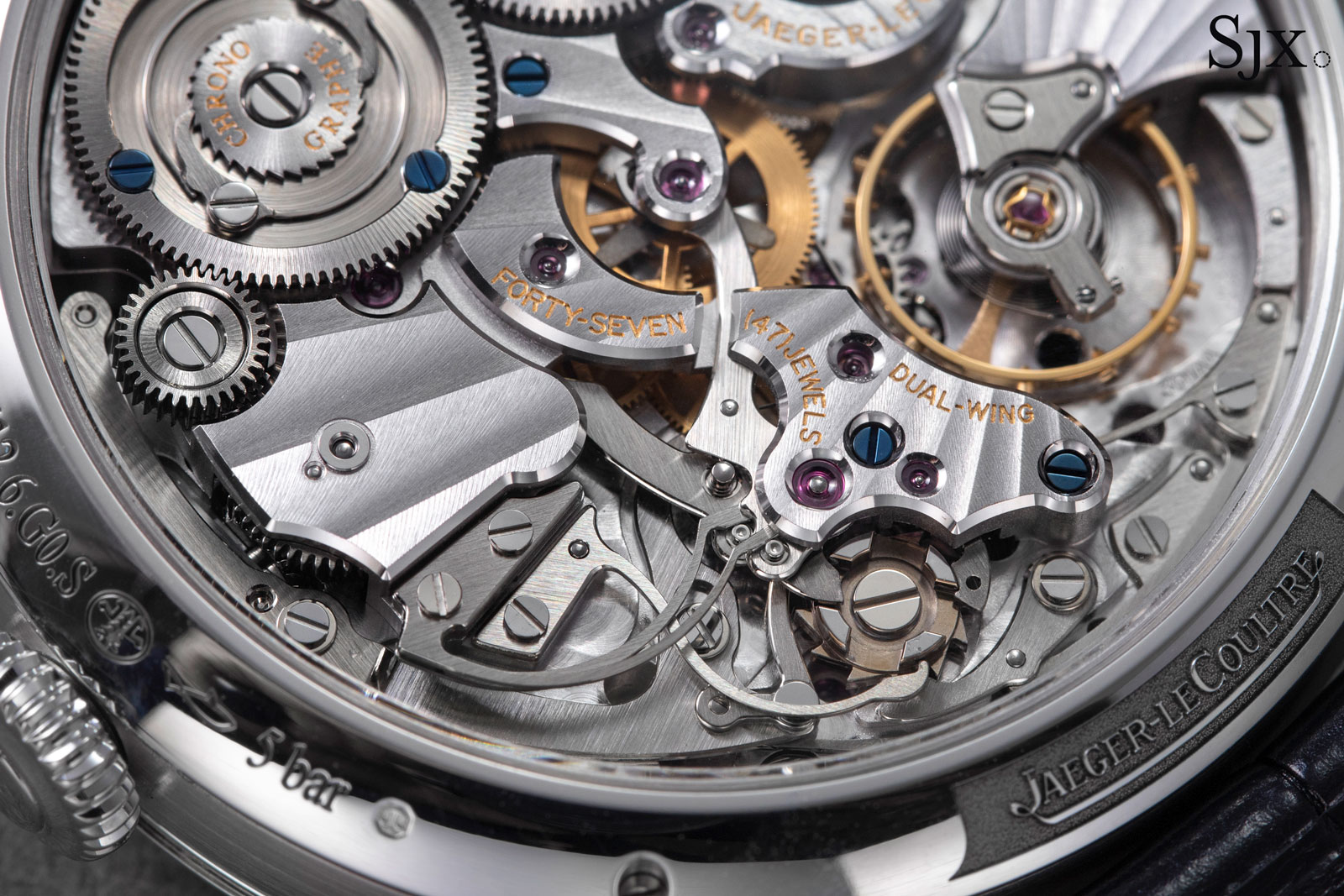
The chronograph relies on a small, four-pillar column wheel
The decoration is quality industrial haute horlogerie, and very similar to the finishing in the first-generation chronograph. It’s evident much of it is done by machine, with a handful of hand-applied finishing touches, but it is done well and it is attractive.
If the Duometre chronograph was priced more affordably, the finishing would be excellent for the price. But where it’s priced should dictate more effort in dressing it up.
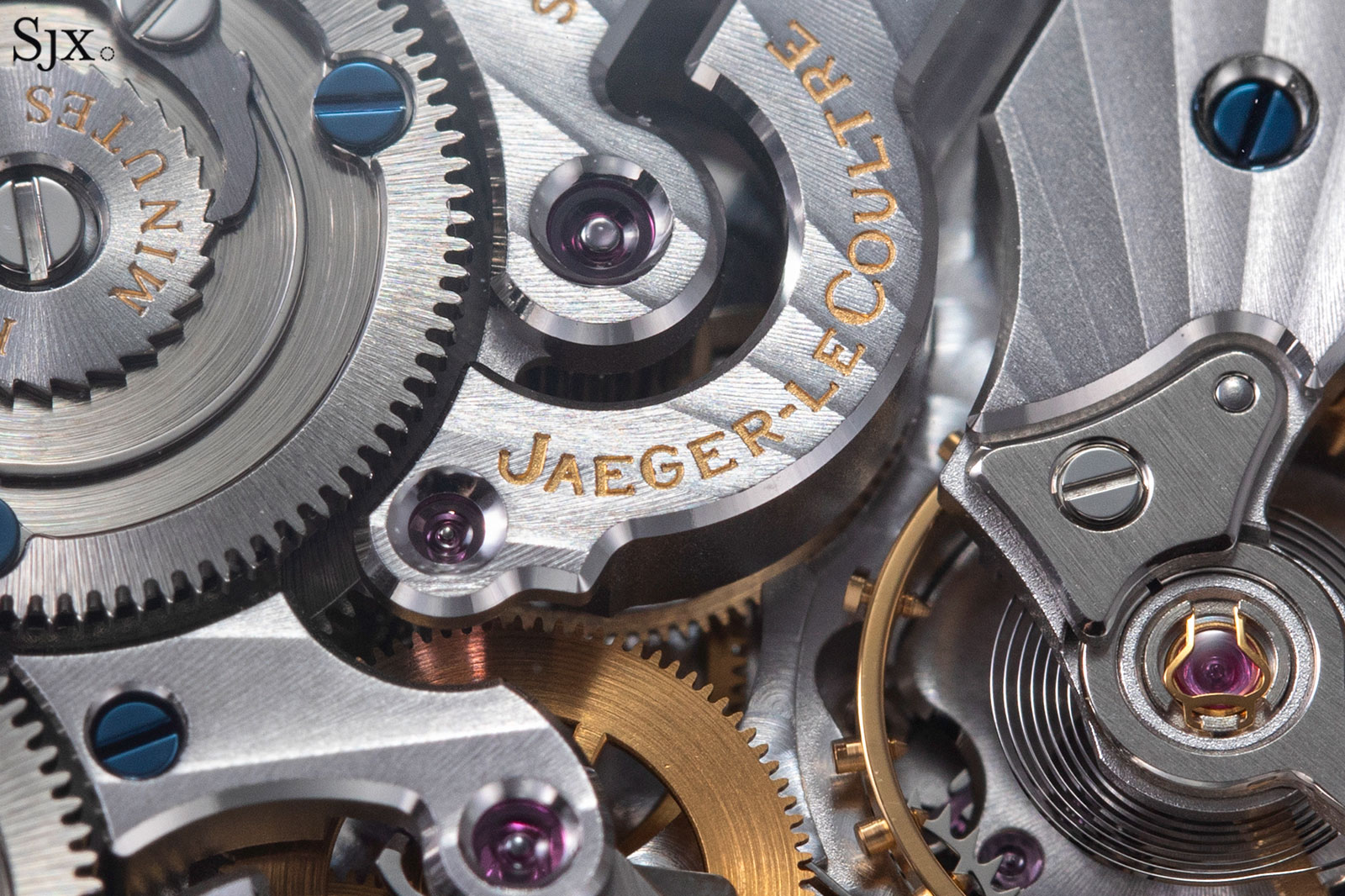
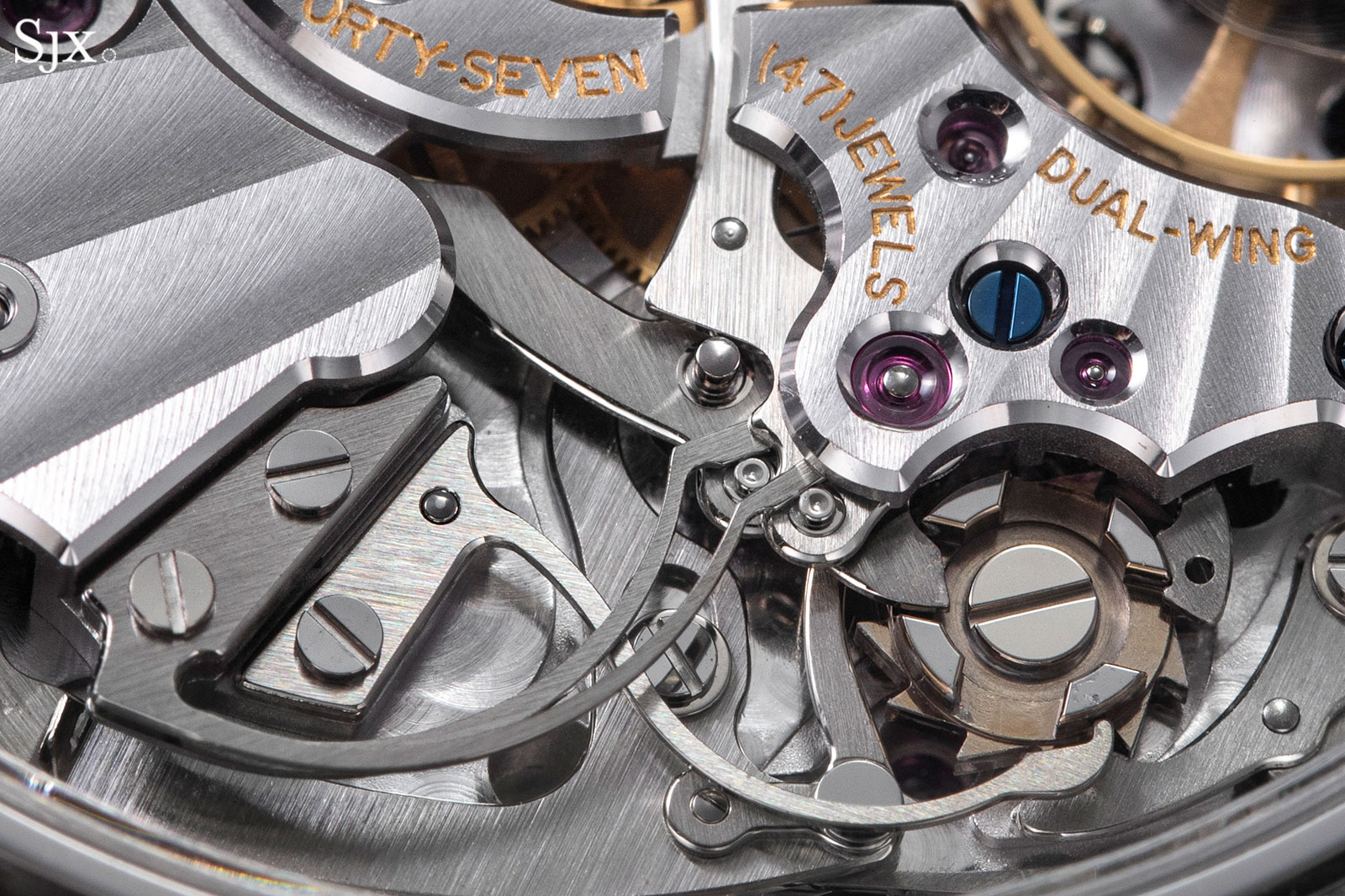
Concluding thoughts
The Duometre Chronograph Moon is appealing, save for the price. While it’s merely a gently reworked movement from 2007, the cal. 391 particular stands out for the high-quality of execution, though the decoration could be better given the cost.
The day-night and moon phase indicators are superfluous and get in the way of the design, though some might appreciate the colour and texture that they bring to the dial. The same applies to the apertures for the power reserve.
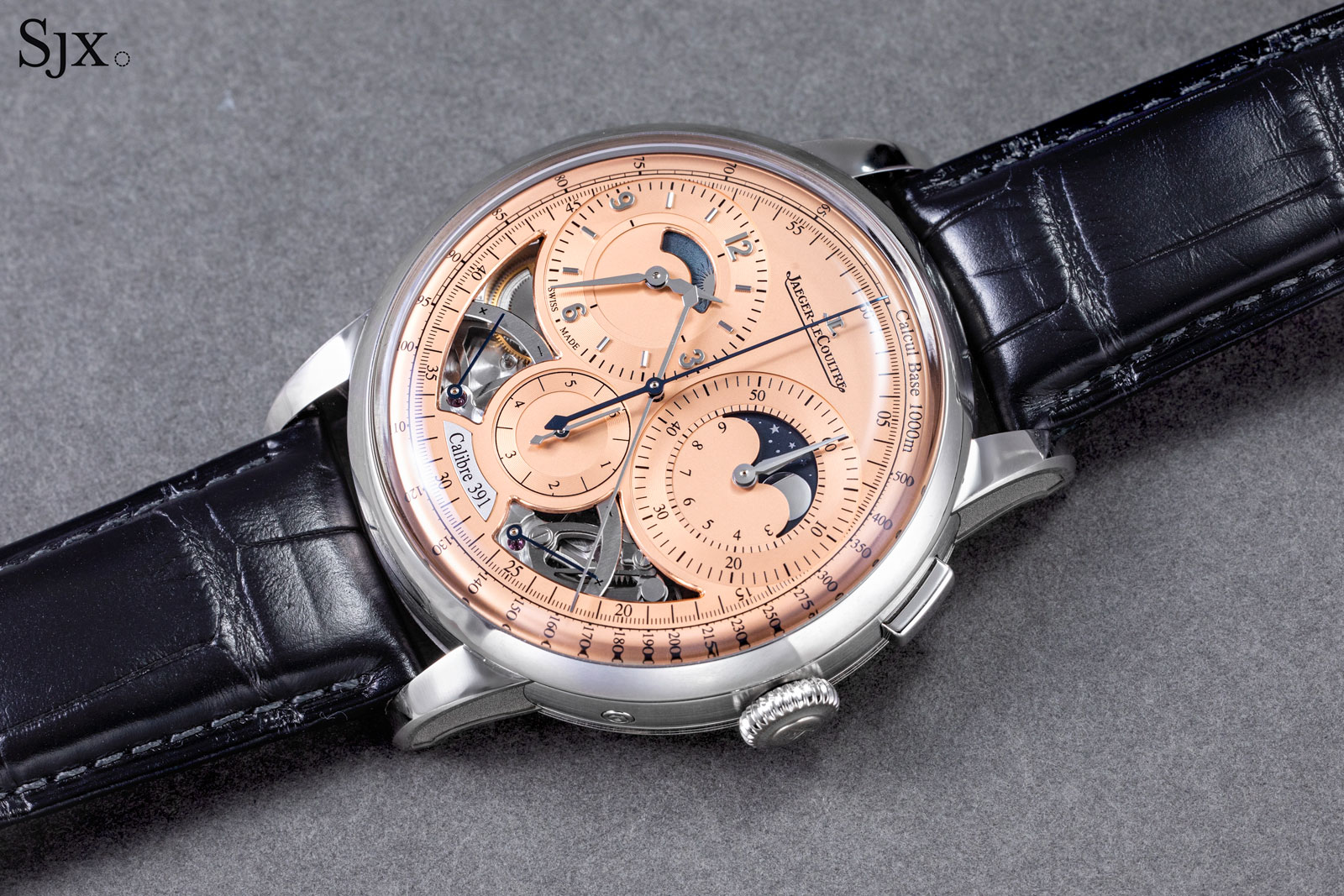
Key facts and price
Jaeger-LeCoultre Duometre Chronograph Moon
Ref. Q622656J (platinum)
Ref. Q622252J (18k pink gold)
Diameter: 42.5 mm
Height: 14.2 mm
Material: Platinum or pink gold
Crystal: Sapphire
Water resistance: 50 m
Movement: Cal. 391
Functions: Hours, minutes, and seconds; chronograph with 1/6th-second foudroyante; date, moon phase, day-night indicator; and double power reserve displays
Winding: Manual wind
Frequency: 21,600 beats per hour (3 Hz)
Power reserve: 50 hours
Strap: Alligator with pin buckle
Limited edition: No
Availability: Now at Jaeger-LeCoultre boutiques and retailers
Price: US$70,000 in pink gold; US$88,000 in platinum
For more, visit Jaeger-lecoultre.com.
Back to top.

